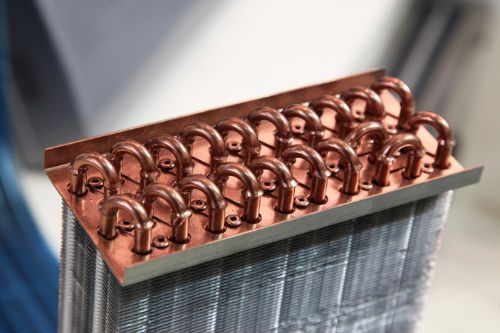What Is a Heat Exchanger?

You may not know what a heat exchanger is, but you rely on it to keep your home warm every day of the winter. Heating the air that passes through your ductwork, the heat exchanger is one of the most important components of your furnace. If it breaks, you face significant repairs and risks to your health. As such, understanding how it works improves your ability to determine what is going on with your furnace.
Where Is the Heat Exchanger Located?
The heat exchanger is located inside the furnace, often above the burner, within the combustion chamber. It is connected to the exhaust flue, which delivers poisonous fuel exhaust out of the home. The heat exchanger itself is a series of tubes through which liquid or gasses can pass from the burners to generate and move heat from one part of the furnace to another. There are many tubes wound fairly tightly together, so that the liquid or gas has many opportunities to increase temperature within a small space.
How Does a Heat Exchanger Work?
The heat exchanger helps to transmit the heat from the furnace to the blower, which can send heated air through your vents into each room. The heat exchanger is connected to the burning fuel coming from the gas valve and the burners. Further down the line, the heat is transferred from the heat exchanger to the blower. The heat exchanger also contains the exhaust from the fuel to be sent up the flue. This separation of the two products is extremely important, because you only want heated air, not carbon monoxide exhaust, flowing through your ductwork.
What Are Common Problems With Heat Exchangers?
The biggest concern you might face with a heat exchanger is that it could become cracked. A cracked heat exchanger is a serious problem, because it can release deadly carbon monoxide directly into your home. Heat exchangers can and do crack, often as a result of overuse of the furnace. Failing to keep your air filters clean could force the heat exchanger to work harder, putting pressure on the component. However, it takes professional skill to identify a cracked heat exchanger. In many instances, failure of your furnace to heat the air may be the fault of another component. If the heat exchanger is the true source of your heating problems, you must seek immediate furnace repair in Sacramento.
A small part of your furnace is responsible for much of your home’s heat, and you may not have even known it was there. With proper maintenance of your furnace, you can look forward to years of effective heating, thanks to your heat exchanger. For expert guidance on the upkeep of all of your furnace components, contact Ace Plumbing.



